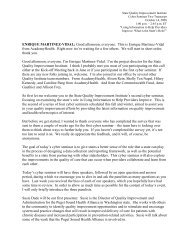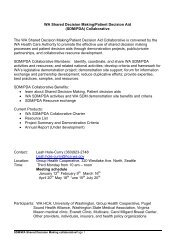In f o r m e d a n d ActivatedPa t ie n t s a n d In d iv id u a l sInform and activate patients and individuals to promote deeper involvement inimproving their health and in making health care decisions.The concept of patients being more actively involved in their health and health care is a dramatic change from the currentstate where most Americans place responsibility for their health and illnesses in the hands of their doctors. Despite clearbenefits of being involved in our own health and health care, our behavior has not kept pace with advances in medicine,technology and health care services. Obtaining the benefit of these advances to prevent, manage and cure disease dependsincreasingly on one’s own energy, knowledge and skills, regardless of whether one is well or sick. 7An informed, engaged and activated patient is one with a clear understanding of his or her own health condition(s), theskills to self manage, and the ability to share responsibility with the provider for the plan of care. Nearly 90 percentof the care a person needs to manage a chronic disease must come directly from the patient. Evidence is growing thatself-management interventions, such as self-monitoring and decision making, lead not only to improvements in healthoutcomes and health status, but also to increased patient satisfaction and reductions in hospital and emergency room costs.It is important to note the difficult challenges this entails. The shift to activation and shared responsibility cannot be donealone; it requires the help of the health care provider and the support of family, friends and the community. It is not justabout giving patients and individuals better resources to make decisions. Much of the health care system is now drivenby extensive marketing to patients and individuals that increase health care costs by encouraging unhealthy habits and theconsumption of high cost health care products and services. Counteracting these messages effectively is not going to beeasy or inexpensive.For this collaborative transformational strategy, activation is defined as “actions that individuals must take to preventdisease and obtain the greatest benefit from knowledge of both disease prevention and the health care services andcoverage options available to them through the health care system.”The Informed and Activated Patients Team identified two broad aims of engaging and activating patients and/orindividuals: managing health care and managing health. (1) Managing health care involves those actions related eitherto the role of patient in the medical encounter or to that of consumer-purchaser of health care services. These two verydifferent roles are expected to work in seamless coordination as patients/consumers navigate the course of seekingcare and making treatment decisions. (2) Managing health involves those actions shown to prevent disease and thoseassociated with the successful self-management of chronic disease. The objective is to encourage, empower and assistpatients and/or individuals to develop the aptitude to acquire and utilize competencies for:• <strong>Health</strong>y lifestyle choices• <strong>Health</strong> care coverage decisions• <strong>Health</strong> care treatment decisions• End-of-life decisions• Cultural transformation to informed and activated patients who are valued partners in all aspects of the envisionedpatient-centered health care system.The following principles characterize an optimal culture of informed and activated patients and individuals:• Partnerships (or shared decision making) between patients and providers/practice teams must be underscored.Collaboration and dialogue are essential to the success of the patient-provider partnership and patient-centeredmedicine. <strong>Health</strong> care and services based on shared decision making increases the likelihood of safe and quality careand positive health outcomes.• A commitment to shared responsibility between patients/individuals and their social environment or the materialconditions of one’s life that impact the well being of individuals and populations. This social environment includes the7 Gruman, J. (2008) A New Definition of Patient Engagement: What is Engagement and Why is it Important. Center for the Advancement of <strong>Health</strong>.Washington, D.C. 2008.16
In f o r m e d a n d ActivatedPa t ie n t s a n d In d iv id u a l spractices and policies of: employers, schools, health care providers, legislators, policy makers, insurers, neighborhoodassociations, and public health officials.• Equity supports a culture of informed and activated patients. It is essential for all actors belonging to the socialenvironment (described above) to understand and address problems of social equity to ensure access to services for allvulnerable groups, including: the poor, disabled, non-English speaking, and racial-ethnic minorities.• Accurate and reliable information must be made available to patients/individuals and providers/teams. Providers andpractice teams must use evidence-based standards, establish common clinical guidelines and evaluation measures.Accurate and reliable information makes it possible for patients to make informed choices and attain optimal health.Additionally, HIT should be leveraged to attain reliable data for practitioners and patients and allow the monitoring ofprogress.• <strong>Health</strong> Literacy must be a priority in order to appropriately engage patients and individuals at various phases intheir life span and those who are differentially involved in their health care. In addition to learning about one’s (or afamily member’s) medical condition, individuals can be encouraged to develop self-care and community-care skills(to incentivize less engaged individuals/patients: training the trainers to do outreach in their communities). Patientswill have access to health resources, personal health records, HIT training, tools and incentives through a workingpartnership with providers, practice teams, public health officials and other health care outreach efforts.• Accountability and Transparency to patients, the public and one another is an essential component of an integratedand collaborative health system. Partnership and dialogue can educate patients on what type of care to expect fromtheir providers and empower them to hold their providers accountable. Additionally, unbiased data that providesinformation about pricing and safety of procedures, devices, and medications, must be a priority.BenefitsPatient activation has the potential to reduce harm; reduce disparities; reduce disease burden; and reduce waste. 8Findings from two separate studies indicate that both patient activation and health literacy contribute to health outcomes. 9While only moderately correlated, both make independent contributions to health behaviors, health choices, and healthoutcomes. <strong>Health</strong> literacy contributes more to choices and the use of information; activation contributes more tohealth behaviors. Another study indicated that activation may help to compensate for lower literacy skill, increasingcomprehension among those with lower literacy. 10There is empirical evidence that giving patients information and involving them in decisions about their health care canresult in beneficial psychological and physical outcomes, including enhanced patient satisfaction, 11 adherence to treatmentplans, 12 and greater confidence in health care recommendations. 13Empirical evidence also suggests that as patients traverse the four stages of activation – (1) the patient does not yet believethat he or she has an active and important role in their health; (2) the patient lacks the confidence and knowledge to takeaction; (3) the patient begins to take action; and (4) the patient maintains behaviors over time – they display behaviorsindicative of becoming fully competent managers of their health. 148 National Partnership. National Priorities and Goals: Patient and Family Engagement. November 2008.9 Hibbard, J.H., Greene, J., & Tusler, M. (2006). An Assessment of Beneficiary Knowledge of Medicare Coverage Options and the Prescription Drug Benefit(Pub I.D. 2006-12). Washington, DC: AARP Public Policy Institute.10 Hibbard, J.H., Peters, E.M., Dixon, A., & Tusler, M. (2007). Consumer competencies and the use of comparative quality information: It isn’t just aboutliteracy. Medical Care Research and Review, 64(4), 379-394.11 Roter, D. L. (‘83). Physician/patient communication: Transmission of information & patient effects. MD State Medical Journal, 32, 260–265.12 Janis, I. (1982). Effective interventions in decision counseling: Implications of the findings from 23 field experiments. In I. Janis (Ed.), Counseling onpersonal decisions: Theory and research on short-term helping relationships. New Haven, CT: Yale University Press.13 Brody, D. S. (1980). The patient’s role in clinical decision making. Annals of Internal Medicine, 93, 718–722.14 Hibbard JH, Mahoney E, Stockard J, Tusler M. (2005). Development and Testing of a Short Form of the Patient Activation Measure (PAM). <strong>Health</strong> ServicesResearch. Vol. 40 No. 6 p.1918-1930.17










